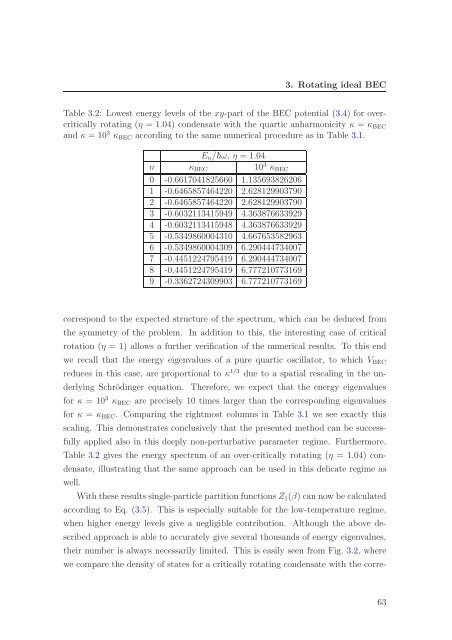PhD thesis in English
PhD thesis in English
PhD thesis in English
Create successful ePaper yourself
Turn your PDF publications into a flip-book with our unique Google optimized e-Paper software.
3. Rotat<strong>in</strong>g ideal BECTable 3.2: Lowest energy levels of the xy-part of the BEC potential (3.4) for overcriticallyrotat<strong>in</strong>g (η = 1.04) condensate with the quartic anharmonicity κ = κ BECand κ = 10 3 κ BEC accord<strong>in</strong>g to the same numerical procedure as <strong>in</strong> Table 3.1.E n /ω, η = 1.04n κ BEC 10 3 κ BEC0 -0.6617041825660 1.1356938262061 -0.6465857464220 2.6281299037902 -0.6465857464220 2.6281299037903 -0.6032113415949 4.3638766339294 -0.6032113415948 4.3638766339295 -0.5349860004310 4.6676535829636 -0.5349860004309 6.2904447340077 -0.4451224795419 6.2904447340078 -0.4451224795419 6.7772107731699 -0.3362724309903 6.777210773169correspond to the expected structure of the spectrum, which can be deduced fromthe symmetry of the problem. In addition to this, the <strong>in</strong>terest<strong>in</strong>g case of criticalrotation (η = 1) allows a further verification of the numerical results. To this endwe recall that the energy eigenvalues of a pure quartic oscillator, to which V BECreduces <strong>in</strong> this case, are proportional to κ 1/3 due to a spatial rescal<strong>in</strong>g <strong>in</strong> the underly<strong>in</strong>gSchröd<strong>in</strong>ger equation. Therefore, we expect that the energy eigenvaluesfor κ = 10 3 κ BEC are precisely 10 times larger than the correspond<strong>in</strong>g eigenvaluesfor κ = κ BEC . Compar<strong>in</strong>g the rightmost columns <strong>in</strong> Table 3.1 we see exactly thisscal<strong>in</strong>g. This demonstrates conclusively that the presented method can be successfullyapplied also <strong>in</strong> this deeply non-perturbative parameter regime. Furthermore,Table 3.2 gives the energy spectrum of an over-critically rotat<strong>in</strong>g (η = 1.04) condensate,illustrat<strong>in</strong>g that the same approach can be used <strong>in</strong> this delicate regime aswell.With these results s<strong>in</strong>gle-particle partition functions Z 1 (β) can now be calculatedaccord<strong>in</strong>g to Eq. (3.5). This is especially suitable for the low-temperature regime,when higher energy levels give a negligible contribution. Although the above describedapproach is able to accurately give several thousands of energy eigenvalues,their number is always necessarily limited. This is easily seen from Fig. 3.2, wherewe compare the density of states for a critically rotat<strong>in</strong>g condensate with the corre-63
















